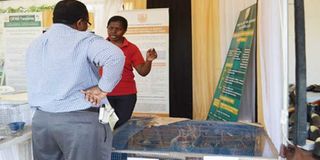Nane Nane Day: where new skills meet users

Ms Mary Magonka, a researcher from the Tanzania Livestock Institute based in Mpwapwa, explains to a visitor about innovate technologies of raising indigenous chicken at this year’s Nane Nane event in Lindi Region. PHOTO | SHARIFA KALOKOLA
What you need to know:
Some of the reasons why technical know-how doesn’t reach the targeted users include insufficient funds and inappropriate strategies of promoting the techniques.
Dar es Salaam. It has become a cliché to say that ‘Research ends up in shelves’. An intelligible transfer of scientific knowledge to the society remains one of the most daunting challenge facing scientists.
Some of the reasons why technical know-how doesn’t reach the targeted users include insufficient funds and inappropriate strategies of promoting the techniques.
The National Farmers Day, commonly referred to as Nane Nane, marked on every August 8 has become an ideal avenue for the media and farmers to access scientific information relevant to them. The government, through the Tanzania Commission for Science and Technology (Costech), has a role of transferring research to the society.
Dr Joseph Maziku, a senior research officer with Costech, says since 2012, the Commission has spent Sh9.7 billion to fund 59 research projects. Out of these, 56 are relevant to agriculture, livestock and fisheries.
Dr Maziku says the projects provide solutions to challenges that the society face.
‘‘We want farmers to use technology to raise their incomes and contribute to national food security,’’ he says.
At this year’s Nane Nane Day in Lindi Region under the theme ‘Big Results Now, Agriculture is Bussiness’, Costech showcased research projects relevant to the farmers in the southern regions.
Here are some of the techniques introduced at the event.
Use of pesticidal plants to fight off rats
Research has found out that Euphorbia candelabrum plants have a great potential of deterring rodents in farms during the seedling stage.
The research aims to produce organic chemicals with no risks to human health. Mr Mashaka Mdangi, is the lead researcher of the project under Agricultural Research Institute.
In his survey in Handeni, Mvomero and Kilosa districts he discovered that more than 85 per cent of farmers use rodenticides like zinc phosphate and termic that may kill non-targeted animals like chicken or other animals that eat the poisoned rat.
“Zinc phosphate is recommended to be applied during massive rat outbreaks with close supervision from specialists,” Mr Mdangi said at the exhibition.
He benefitted from Costech funds in order to transfer the technology during the event.
The study that started in the year 2012, highlighted Euophorbia candelabrum specie has components that fright rats in his study with Mastomys natalensis.
These plants are capable to endure harsh environmental conditions and are available in many areas in Tanzania.
Mr Mdangi said mixing 200 grams of pounded Euphorbia candelabrum with a kilo of maize seeds a day before sowing is sufficient to protect the seeds from rats. “The taste of the plant scares rats away,” he says.
Rats cause more than 80 per cent damage to maize seeds depending on season and location.
Damages of up to 100 per cent may be experienced during rodent outbreaks, according to him. “With the funds from Costech we have trained farmers in Mazingara and Kwachaga villages in Handeni District on rodent biology, ecology and management,” he said adding he is still testing some other more pesticidal plants and improve the efficacy of E. candelabrum.
‘‘Our next endeavour is to extract components from pesticidal plants that deter rats and make chemicals with the same characteristics,” he added, “We are closely working with the Muhimbili University, Institute of Traditional Medicine under Dr Magadula Joseph Jangua as a co-researcher”.
Tsetse fly control using targets
There have been a massive migration of herders from the northern regions southwards in search for good pasture and water since the early 2000s.
Coast, Lindi, and Mtwara regions have good rains, fertile soils that suits agriculture as well as livestock keeping.
However, pastoralists face the challenge of tsetse flies – insects that feed on cattle and human blood -- in these areas. They transmit parasites that cause sleeping sickness in humans and nagana (African Animal Trypanosomiasis) in animals.
As a result, cattle experience high fever, progressive anaemia, abortions for pregnant animals and reduced milk and meat production. The animals may die if not treated in time.
With Costech funds, the Vector and Vector Borne Diseases Institute (VVBDI) based in Tanga initiated control options that could work in the affected areas. The research identified the population, distribution, species, sex, and infection rates of tsetse flies in the southern regions.
Mr Gideon Kasilagila, the principal livestock research officer and the lead researcher of the project, said they used tsetse traps baited with odours to study the distribution of flies in the areas. They also collected blood from livestock and found that 8 per cent of the cattle were infected by trypanosomas. The study was conducted in Rufiji, Kilwa, Lindi Rural and Liwale districts from 2012 to 2014.
Six villages from Rufiji, Kilwa and Liwale districts have been selected as models of tsetse control using odour baited targets.
“The device is easy to deploy, low-priced, eco-friendly and community oriented for sustainability,” Mr Kasilagila said.
The researcher said between August and September 2014, the project will deploy about 2,500 targets and 100 traps in Liwale, Kilwa and Rufiji. “Our survey has shown that Liwale has the highest numbers of tsetse flies,” he said. This project has sparked interest to councillors in Liwale District. Mr Hashim Manjanjagara, the vice chairman of Liwale District Council says Liwale is in need of the technology because cases of animals that are infected with the flies are rising.
Indigenous chicken
Ms Mary Magonka, a researcher from the Tanzania Livestock Institute based in Mpwapwa, has studied on the bst indigenous chicken ecotypes and ways of increasing their yields. Her research identified among four ecotypes that were evaluated, two of them; Horasi and Kishingo ecotypes were the best when it came to laying and hatching eggs, disease resistance, and they also have a favourable weight after a period of six months. At the Costech booth the researcher trained farmers on the technique of increasing the number eggs and chicks in a year. This is by separating the chicks from their mothers soon after hatching and raising them in a brooder. She also trained farmers on making a low cost brooder by using mud bricks. She informed the farmers on making an affordable heating system using a charcoal.
Fruit fly control
Ms Beatrice Mruma, a researcher from Mikocheni Agricultural Institute, showcased a technology on controlling fruit flies using different interventions.
Fruit flies destroy fruits such as mangoes, avocados, pawpaws, oranges, and bananas. The female fruit fly lays eggs on the fruit and after few days it hatches the eggs into larva which feeds on the fruit flesh until the fruit decays and falls down from the tree. Her study identified those solutions to control fruit flies such as field sanitation that is, picking fruits that have fall of from the tree and burying them in the ground so as to destroy the larva in the decayed fruits.
The other solution is by collecting the fallen fruits and placing them in a black polythene bag and exposing the bag in the sun so as to kill the larva. The study pointed out the use of pheromone trap as another way of controlling the flies. The pheromone is a hormone that attracts only male fruit flies. It is mixed with an insecticide that is put in the traps.
There are two types of traps -- bottle trap and bucket trap. The bottle trap can easily be used by a farmer because it is inexpensive. The bucket trap is commercial trap sold at Sh3,000. The trap’s efficiency last for two months and has to be recharged. Five pheromone traps are sufficient to protect one acre of a fruit farm. The other intervention is by spraying using food bait (mazoferm or molasses). Food baits are commercially available in vetenary shops.
Ms Sharifa Kalokola is a science communicator who can be reached at [email protected] or +255 719 540 069
“To make a spraying solution you have to mix five mls of insecticide (nuvan) , 50mls of food bait (mazoferm) and a litre of water,” Mruma added, “The mixture is sprayed on one square metre of a tree canopy. A litre of the mixture is sufficient to spray 20 trees. The treatment should be done after 10 to 14 days until the end of the harvesting season.”
The other intervention is the use of red weaver ant (maji moto) that feeds on fruitflies and other insects that feed on flowers, fruits and leaves.
This project is implemented Muheza District in Tanga Region, and Mkuranga and Kibaha districts in Coast Region.
Mruma said that when these techniques are not used farmers may experience losses of 50 to 80 per cent. “Every farmer must control fruit flies,” she urged.
A farmer, Mr Ally Omari, based in Lindi was inspired by the fruit fly techniques because he had experience losses in his mango farm. The farmer decided to cut down all trees to make charcoal instead.
“I wasn’t aware that the fruitflies were the reason for my losses. I call upon scientist to train us more on fruit farming management and educate us on how to access insecticides,” he said.




